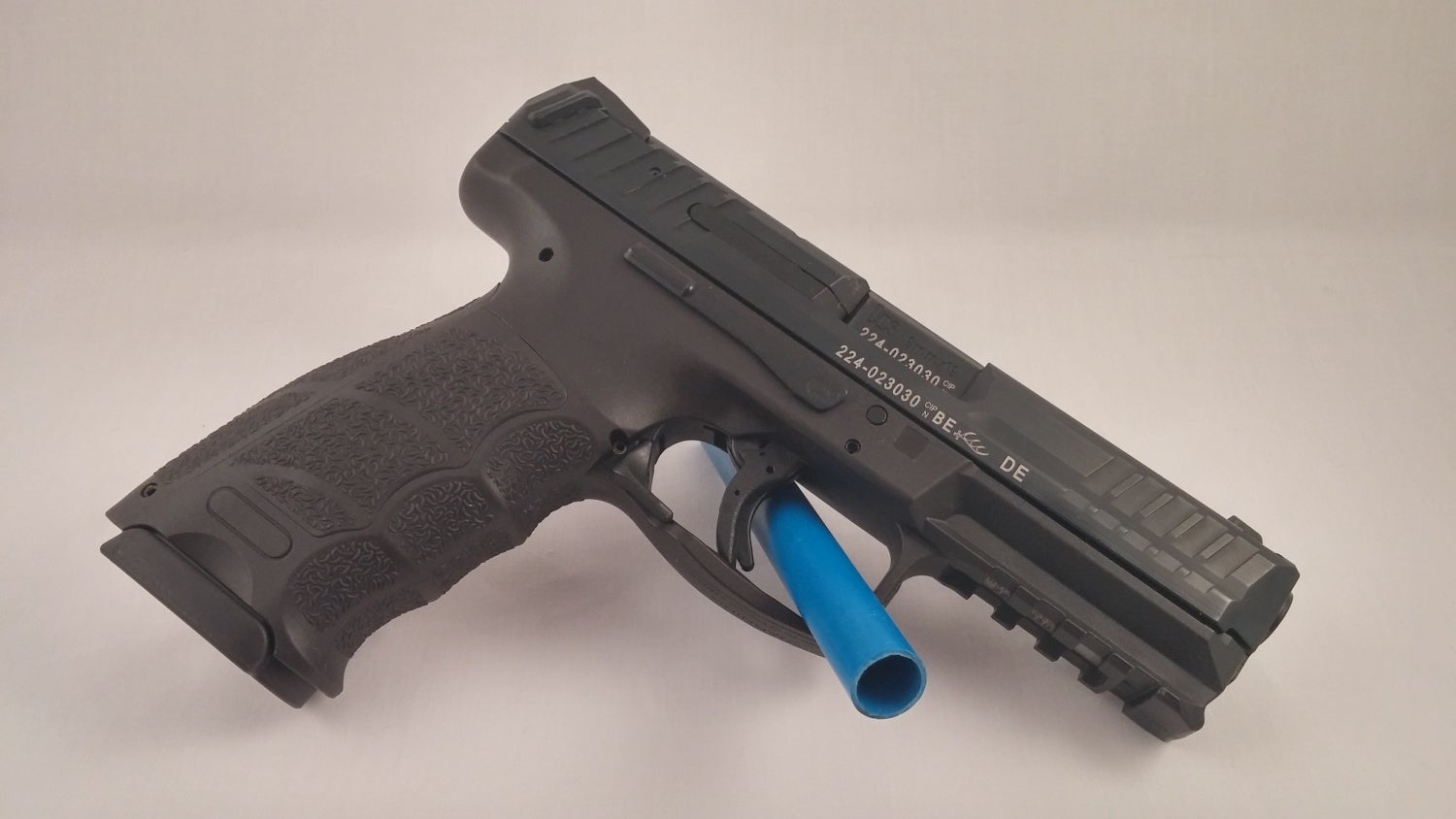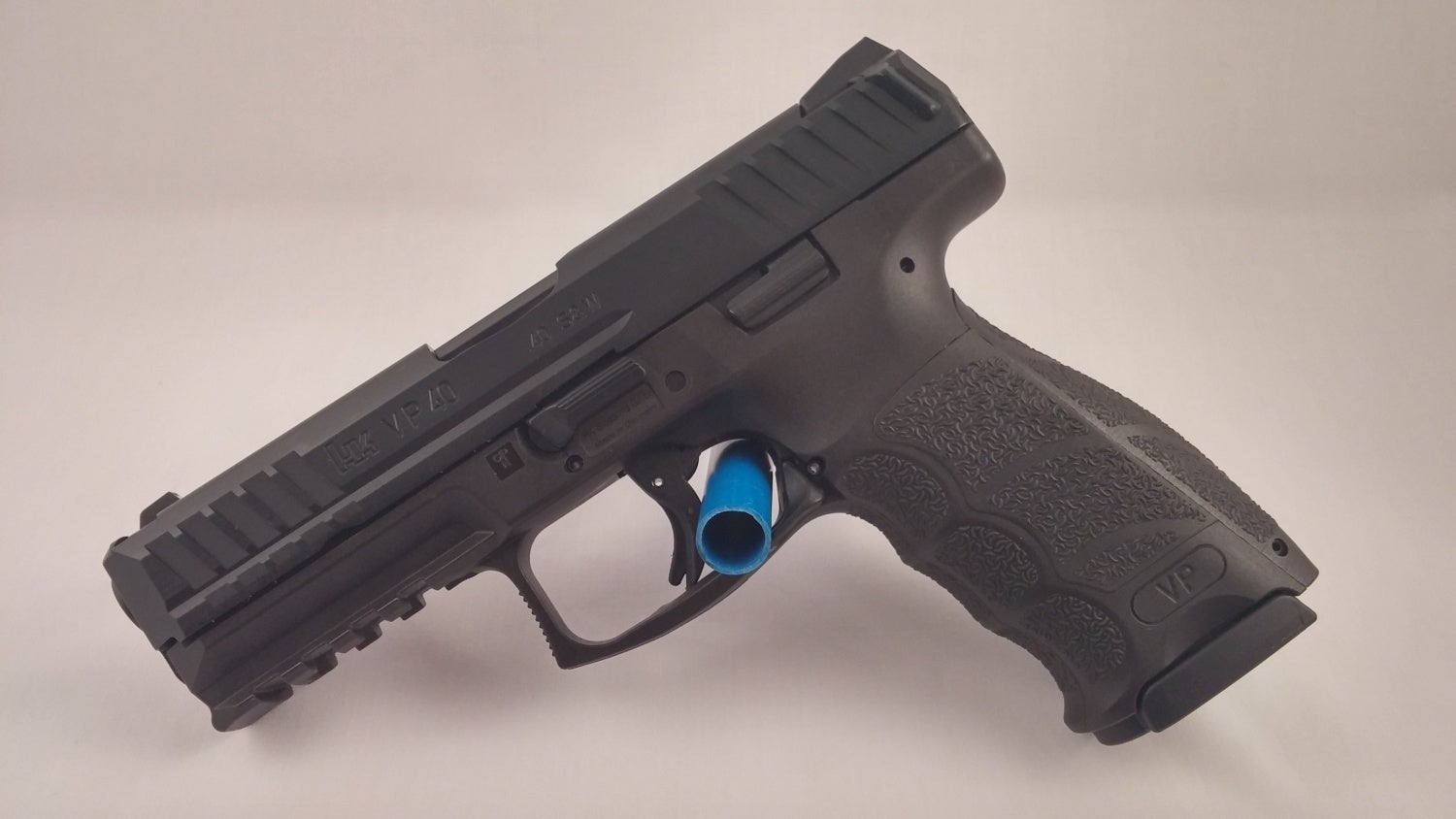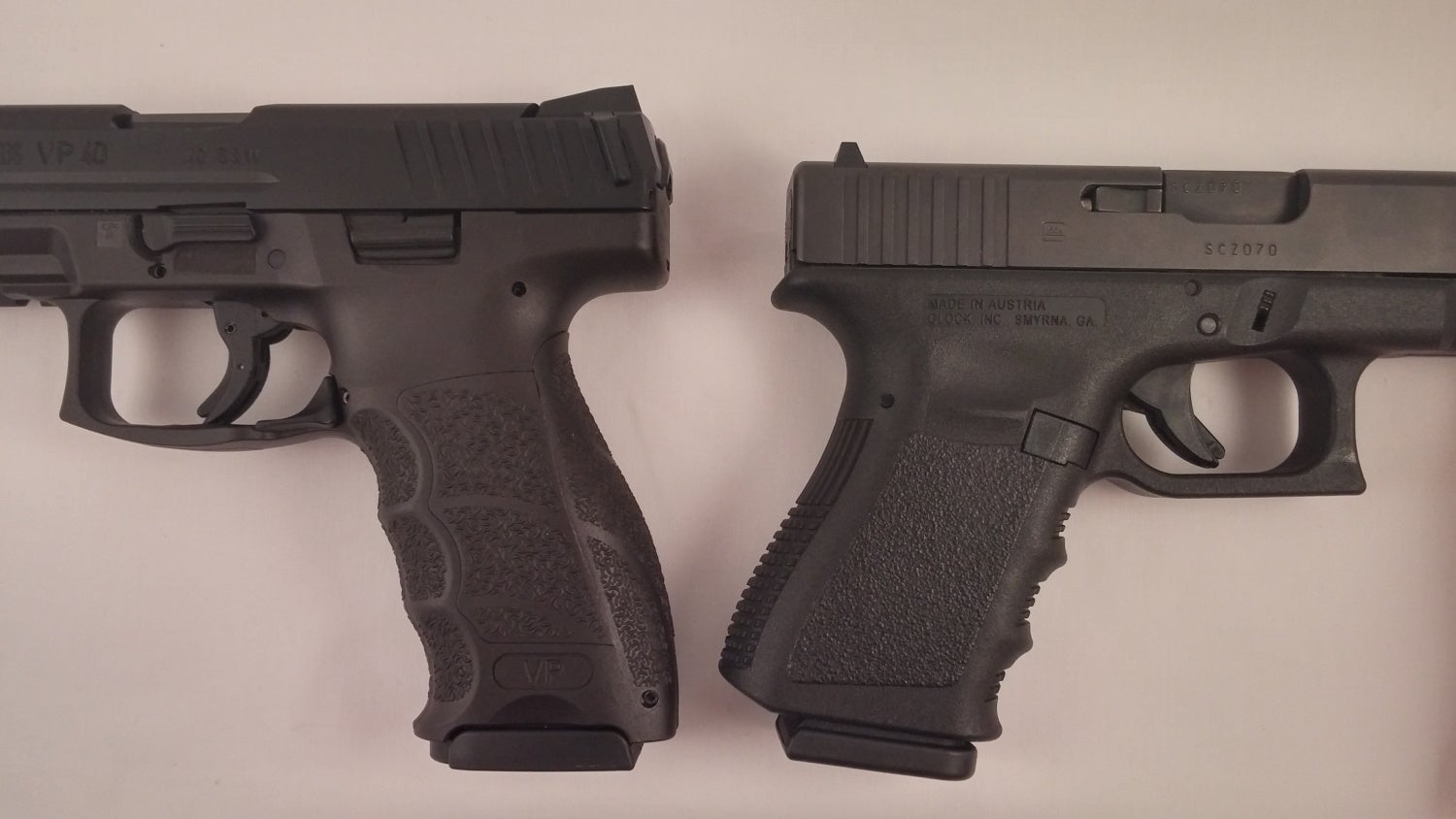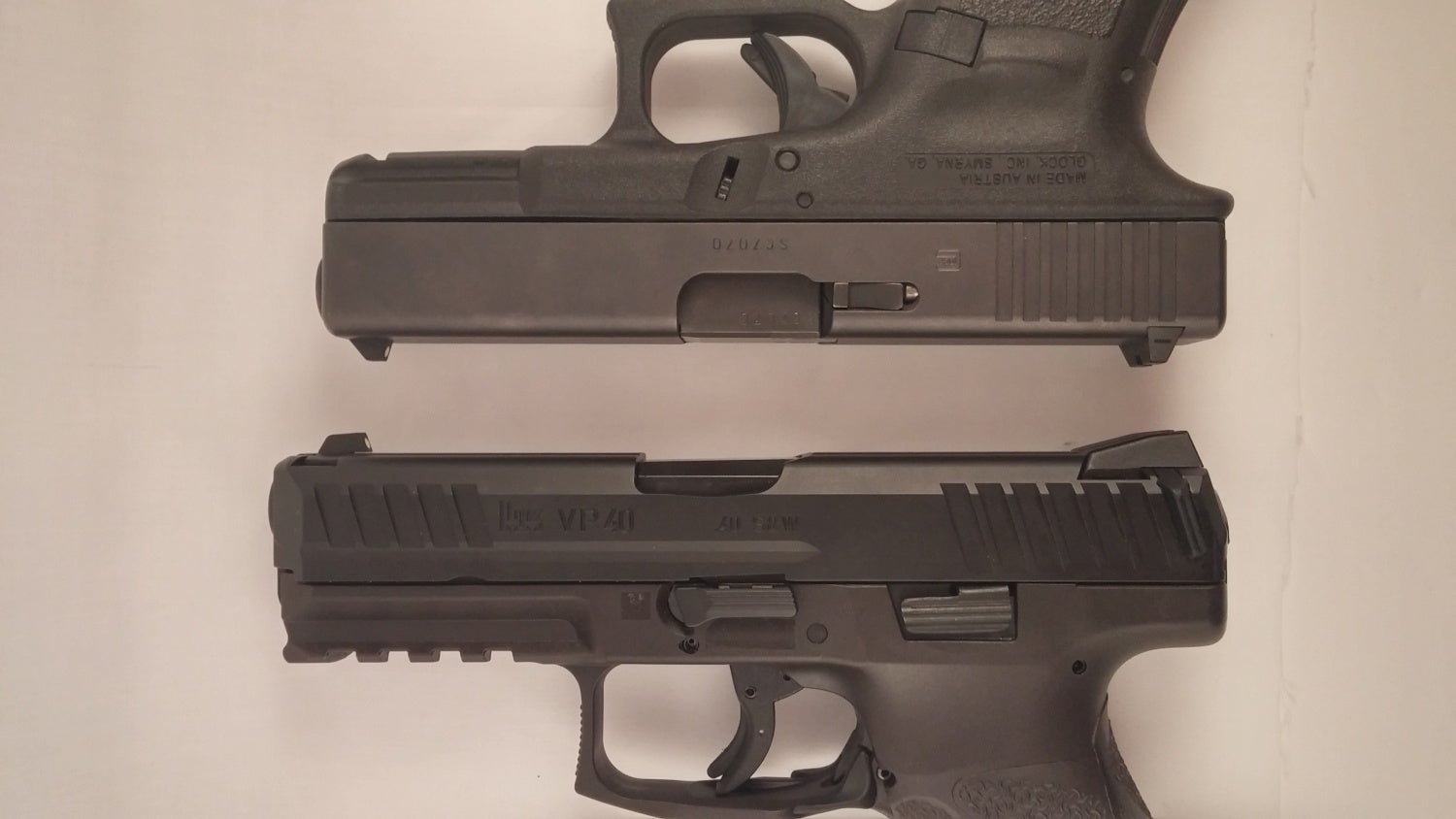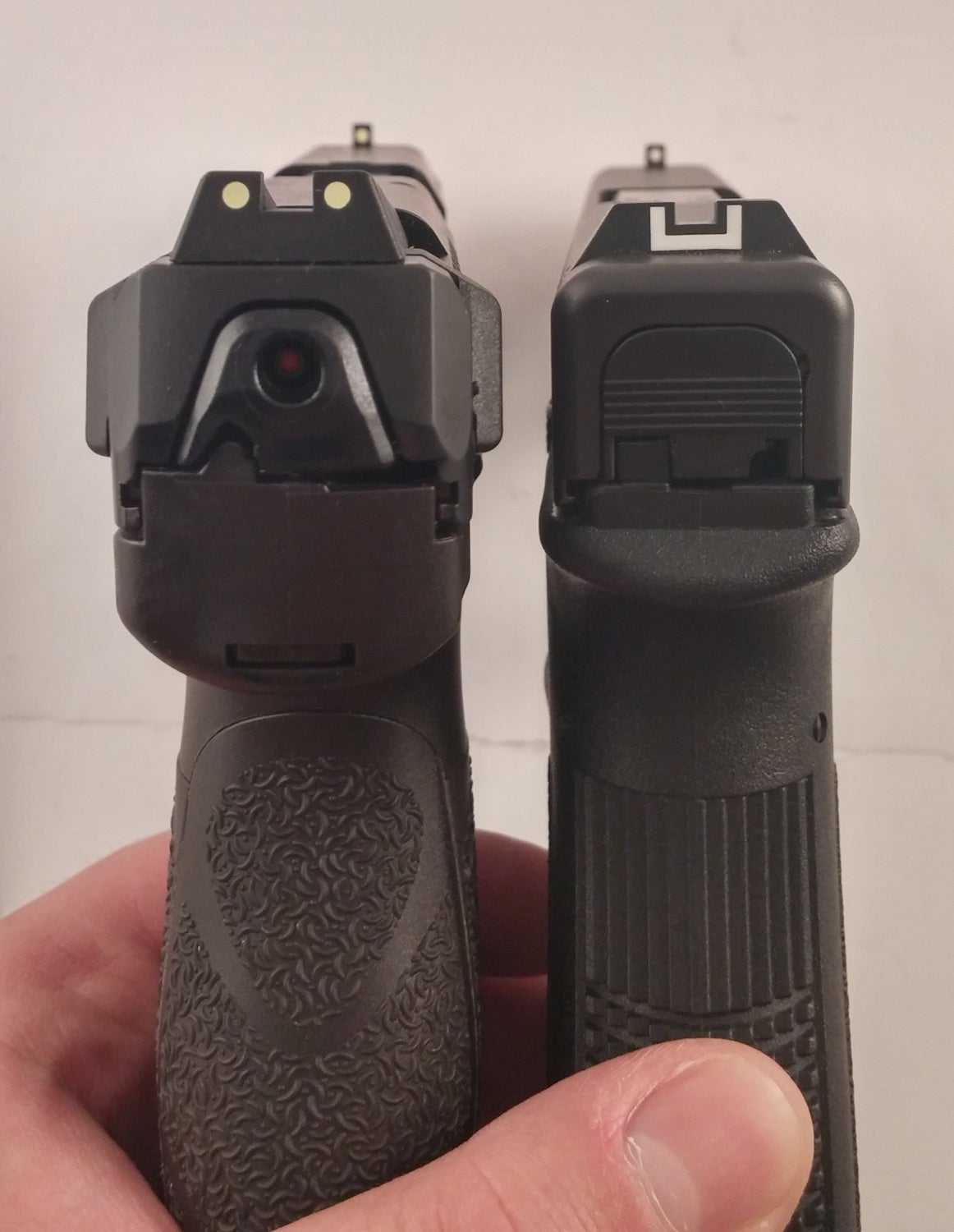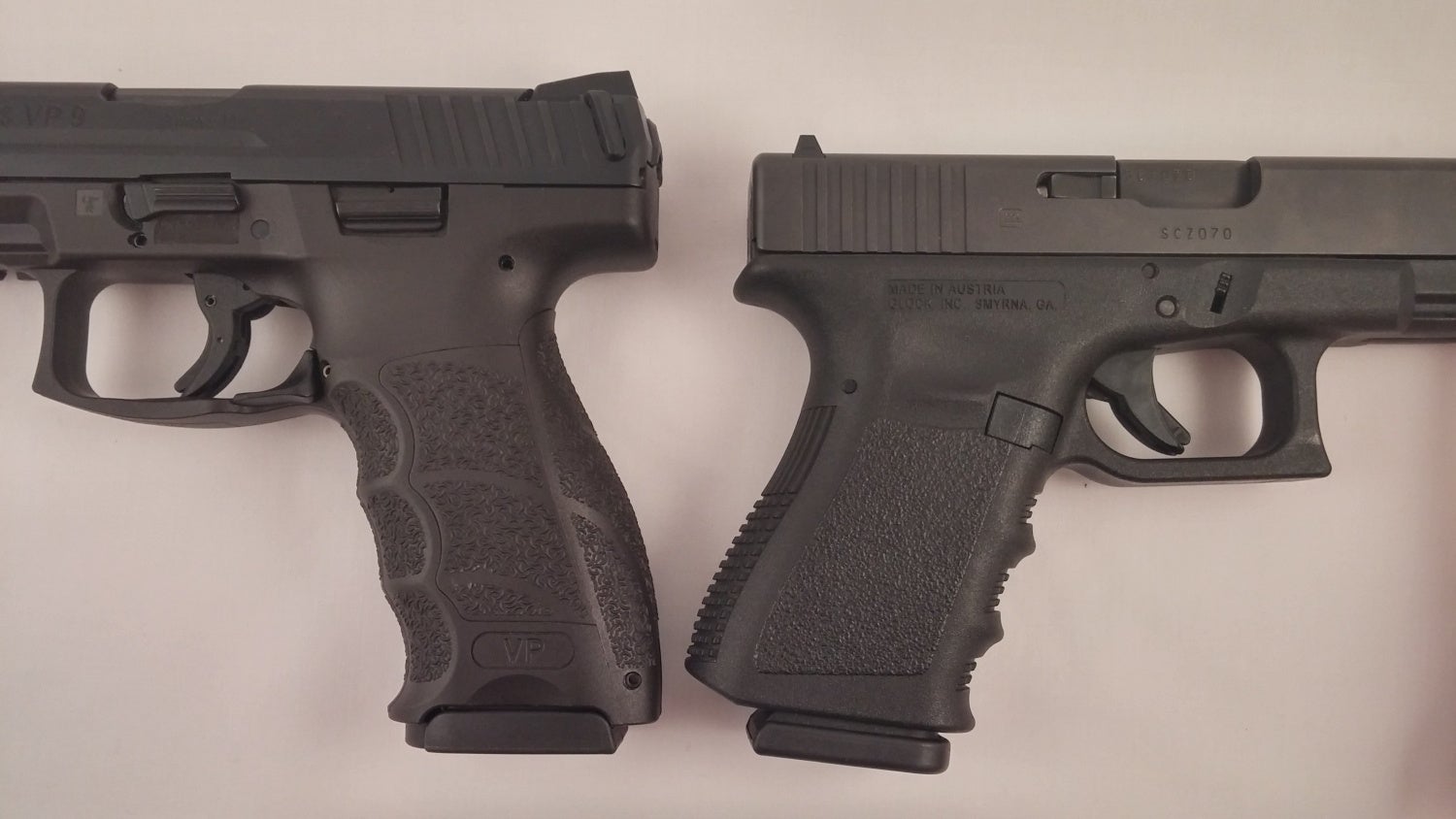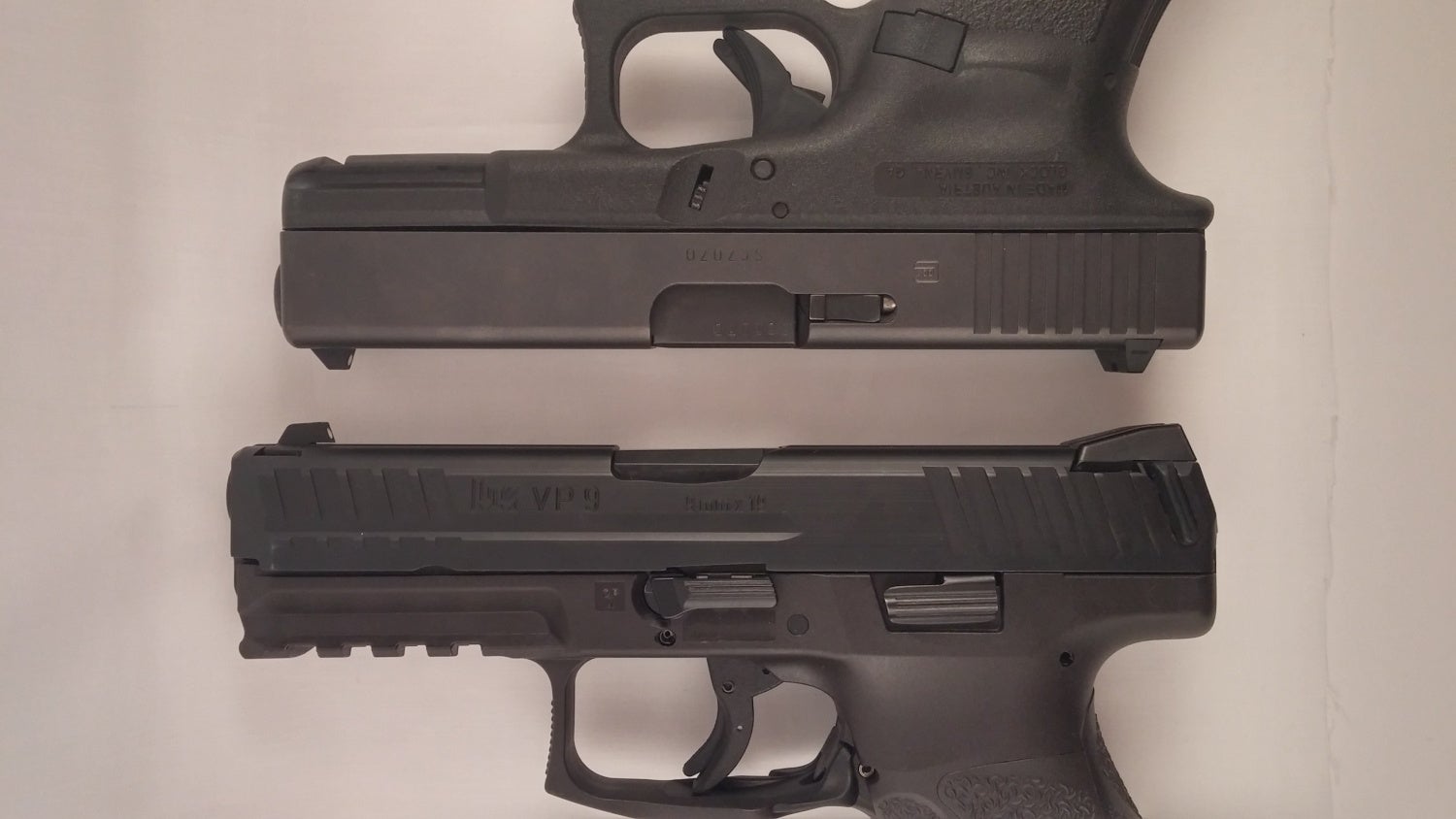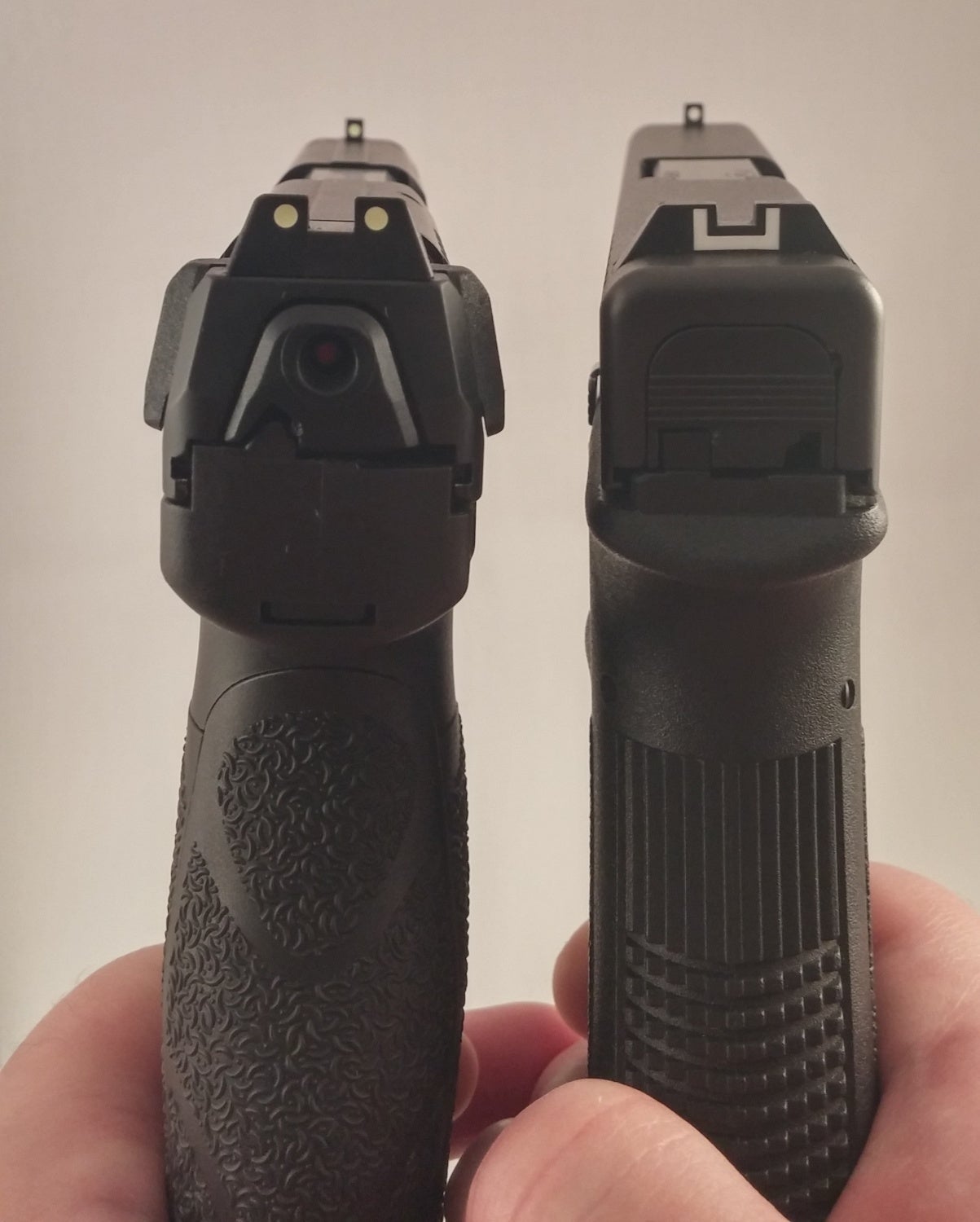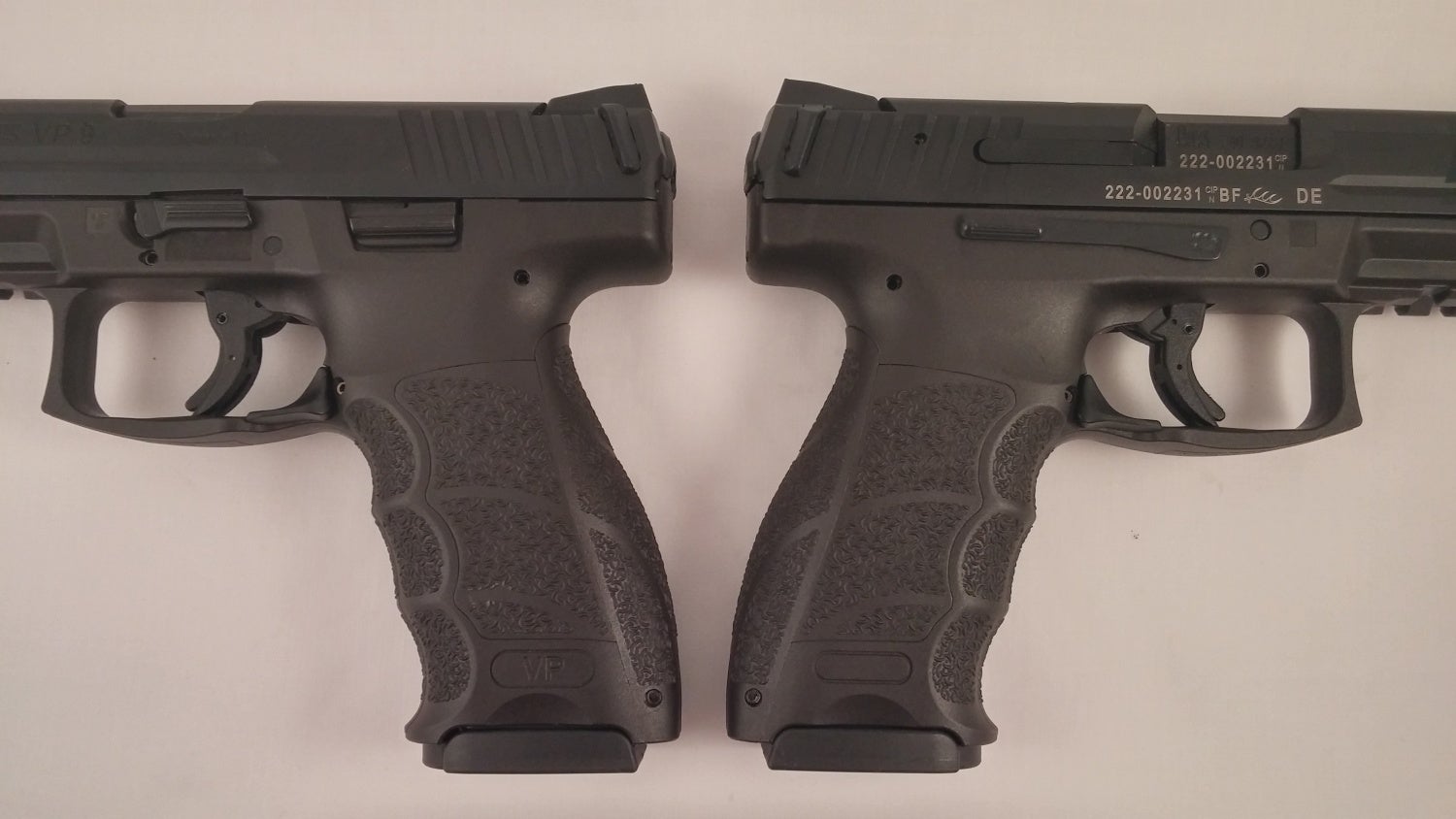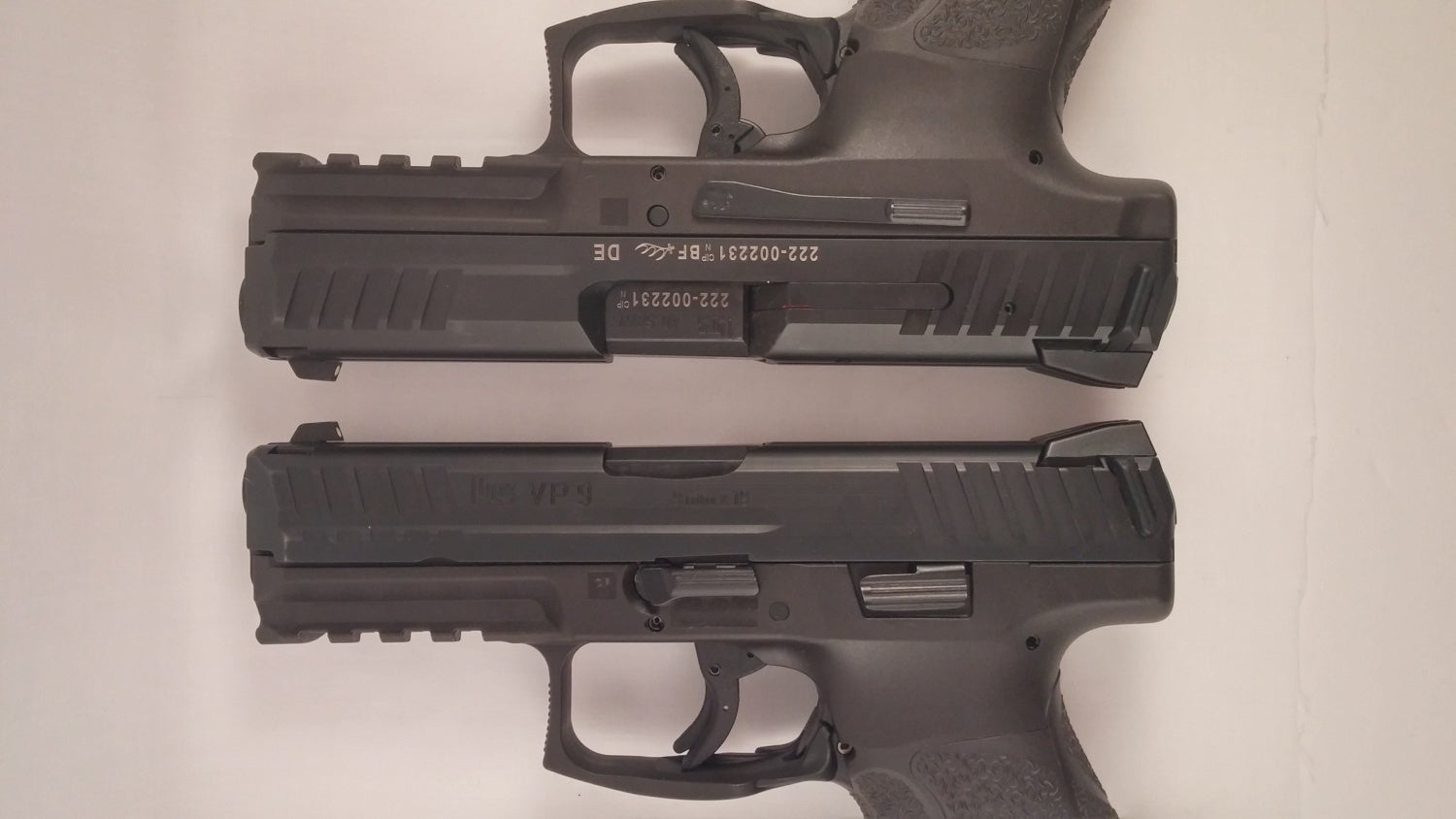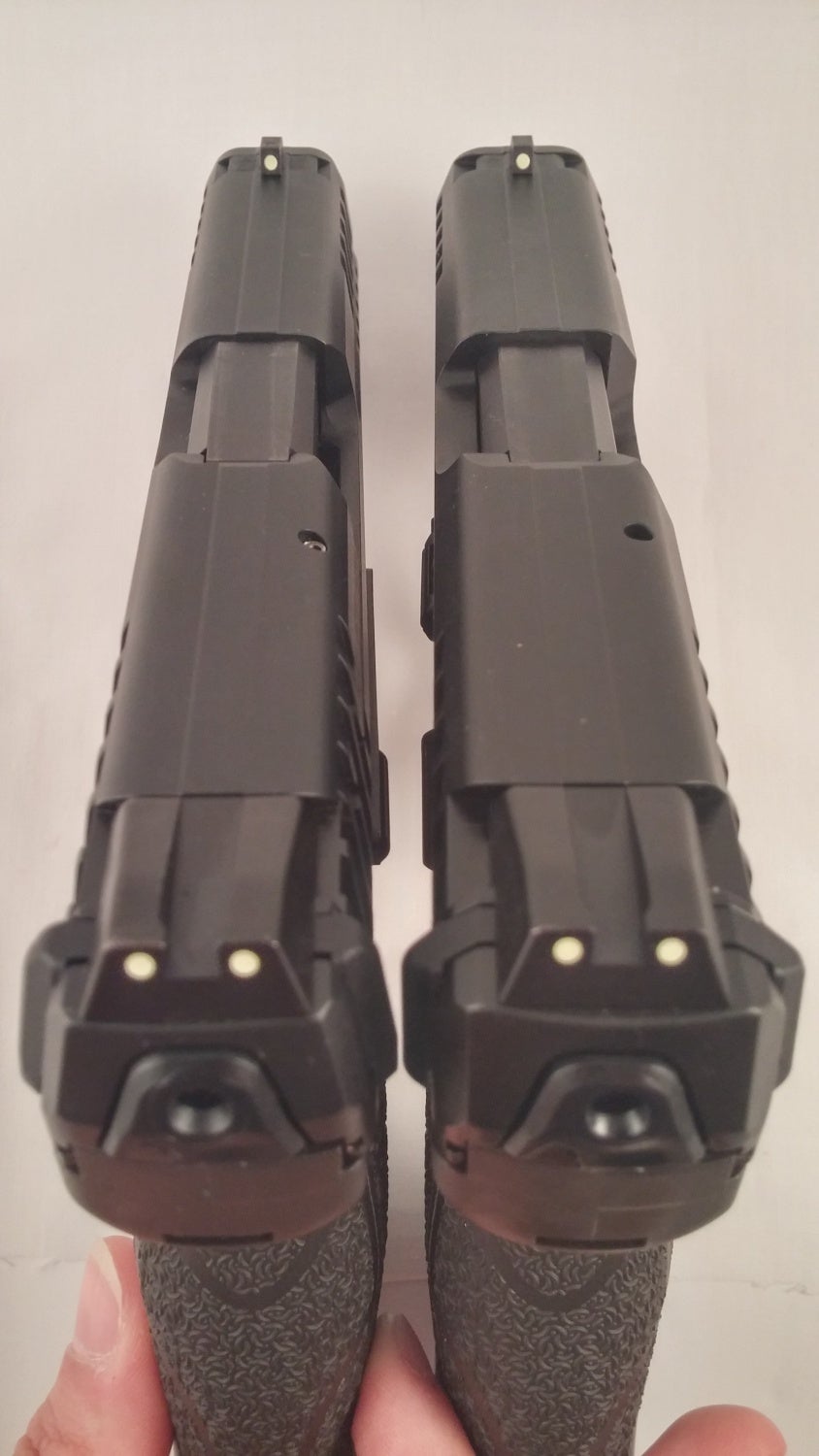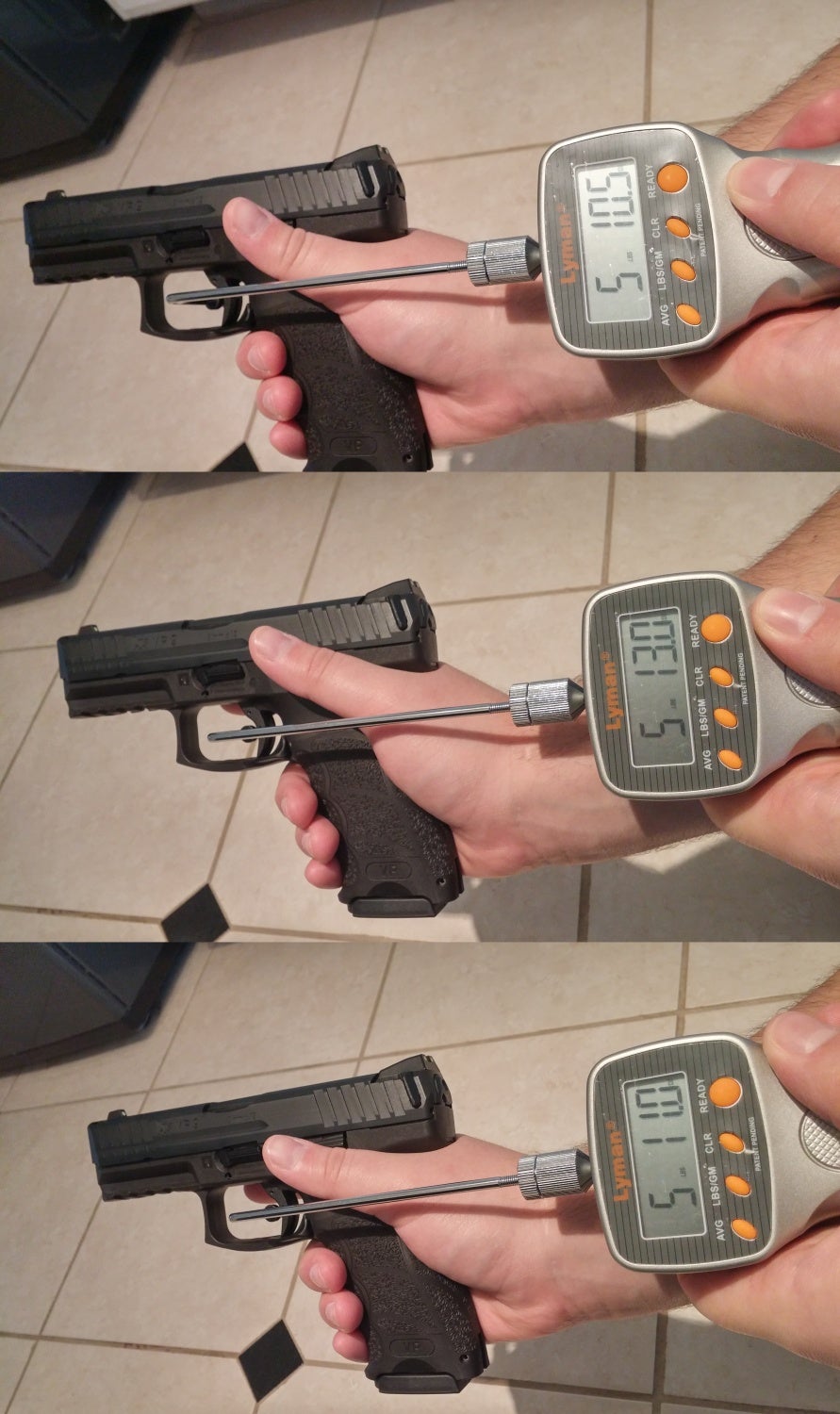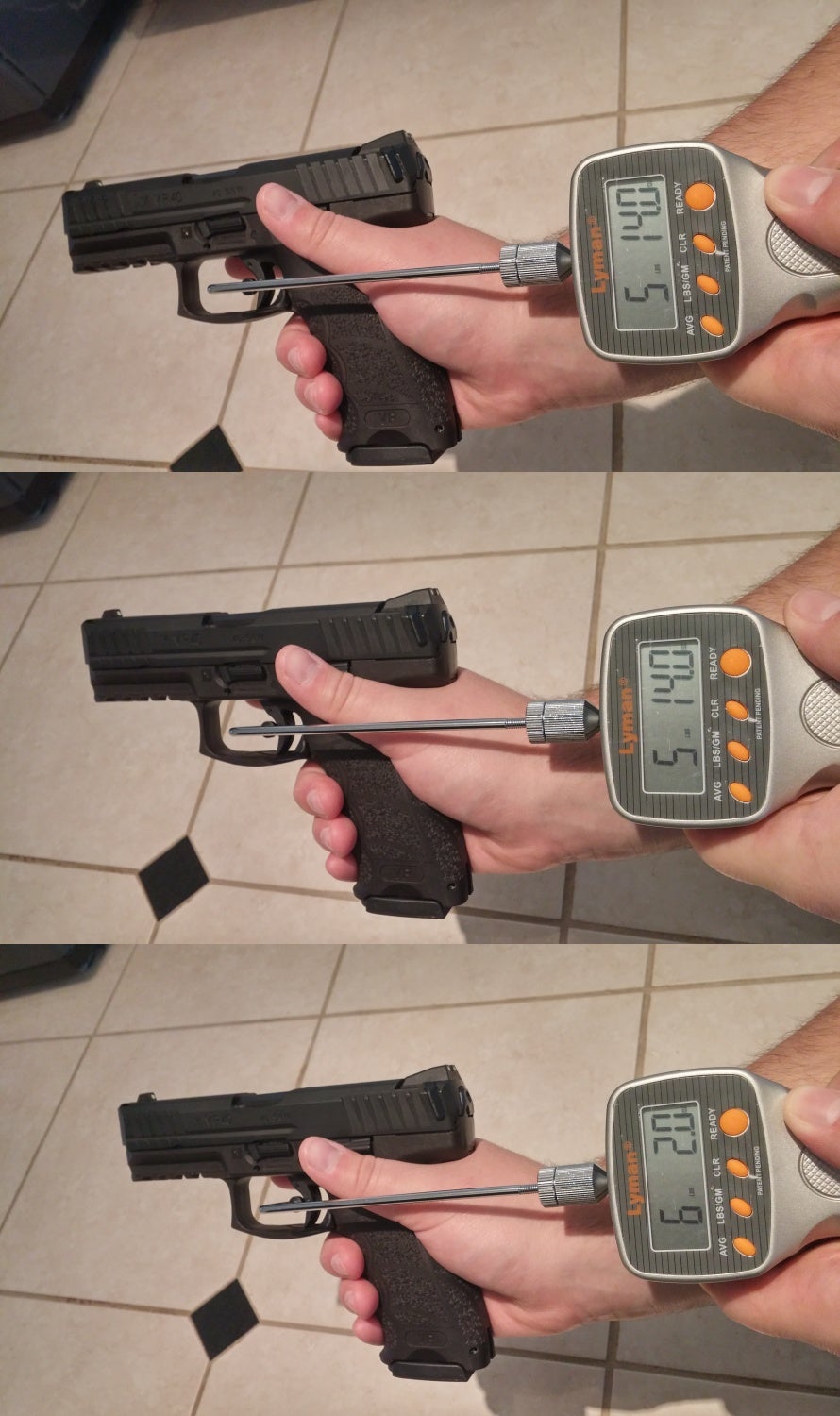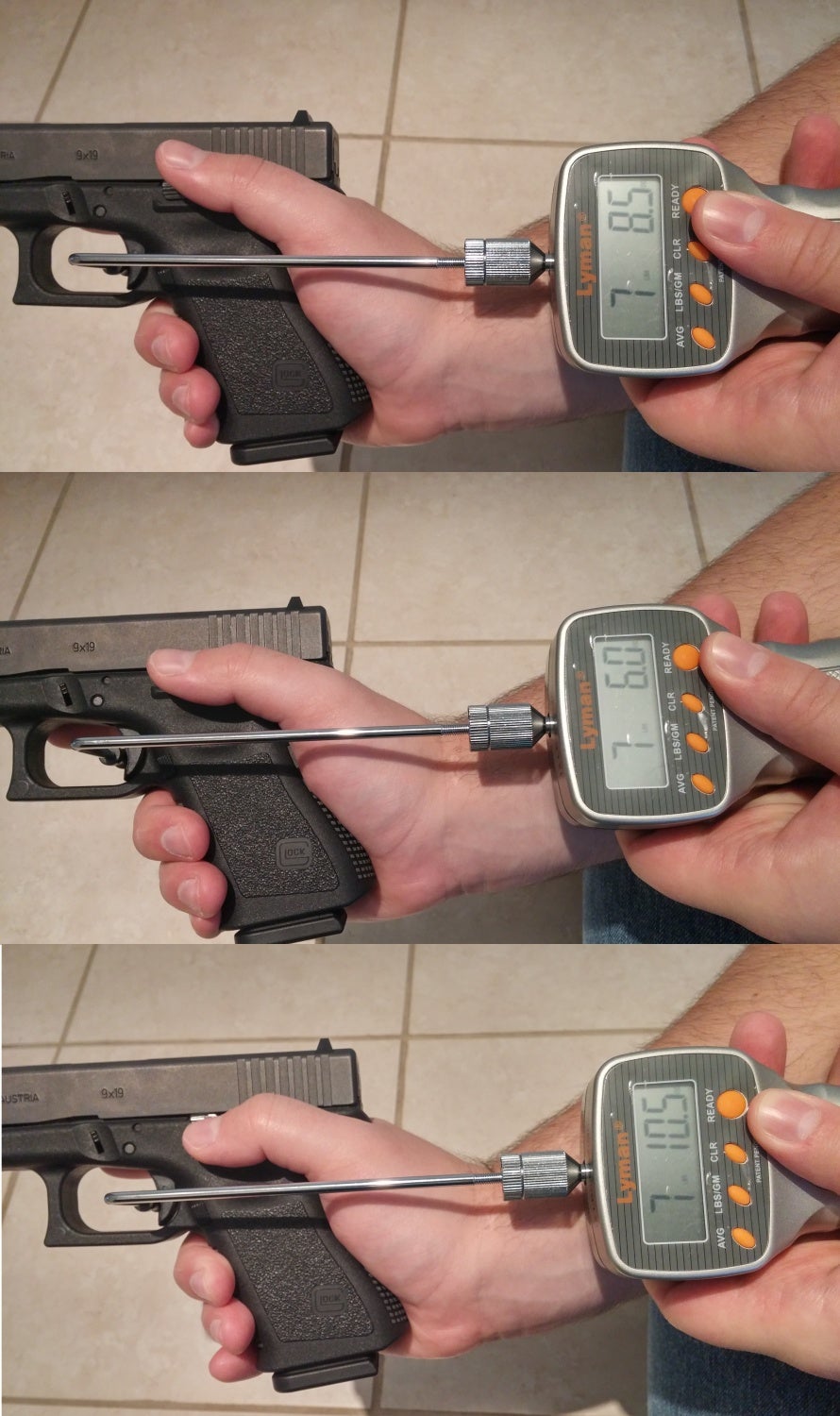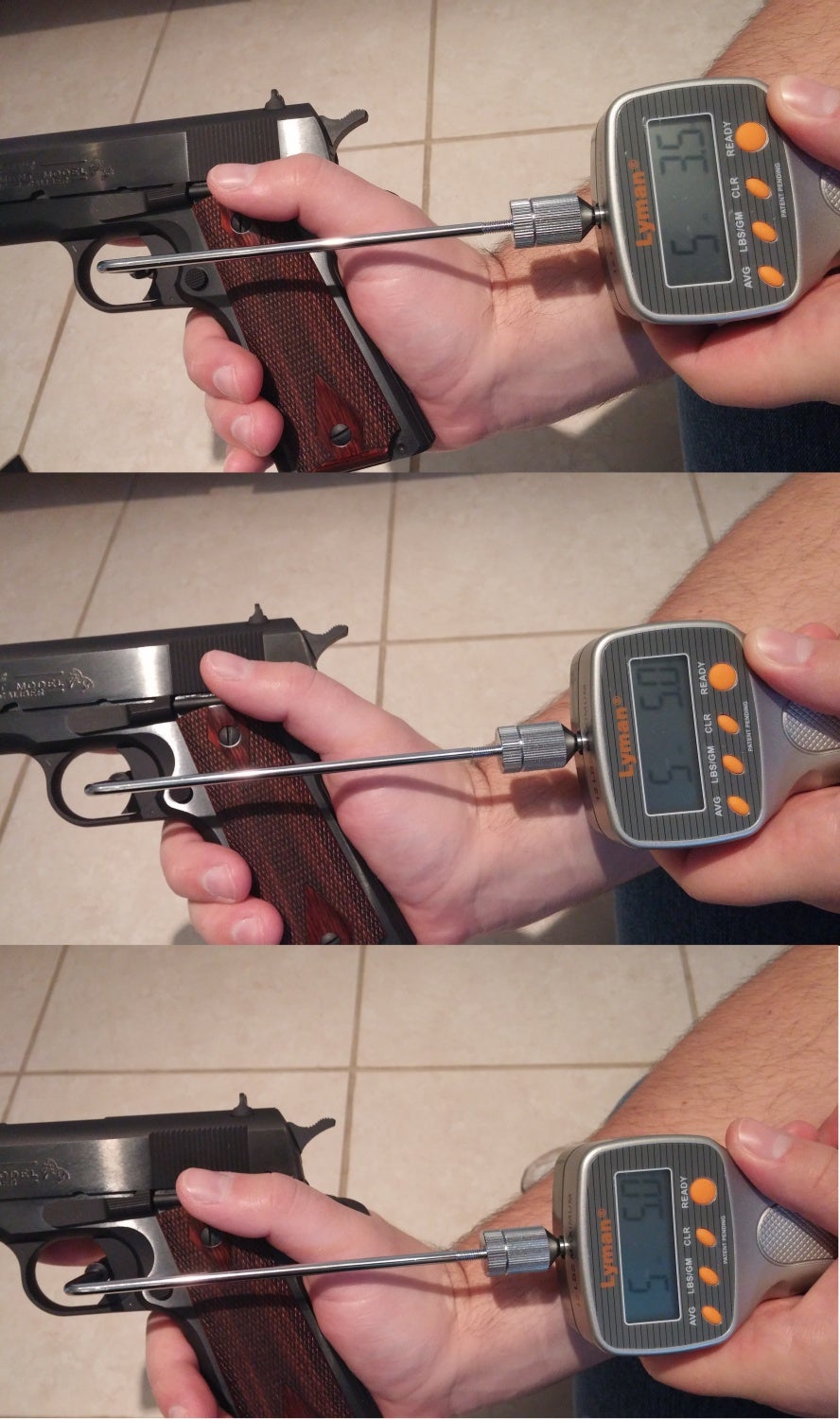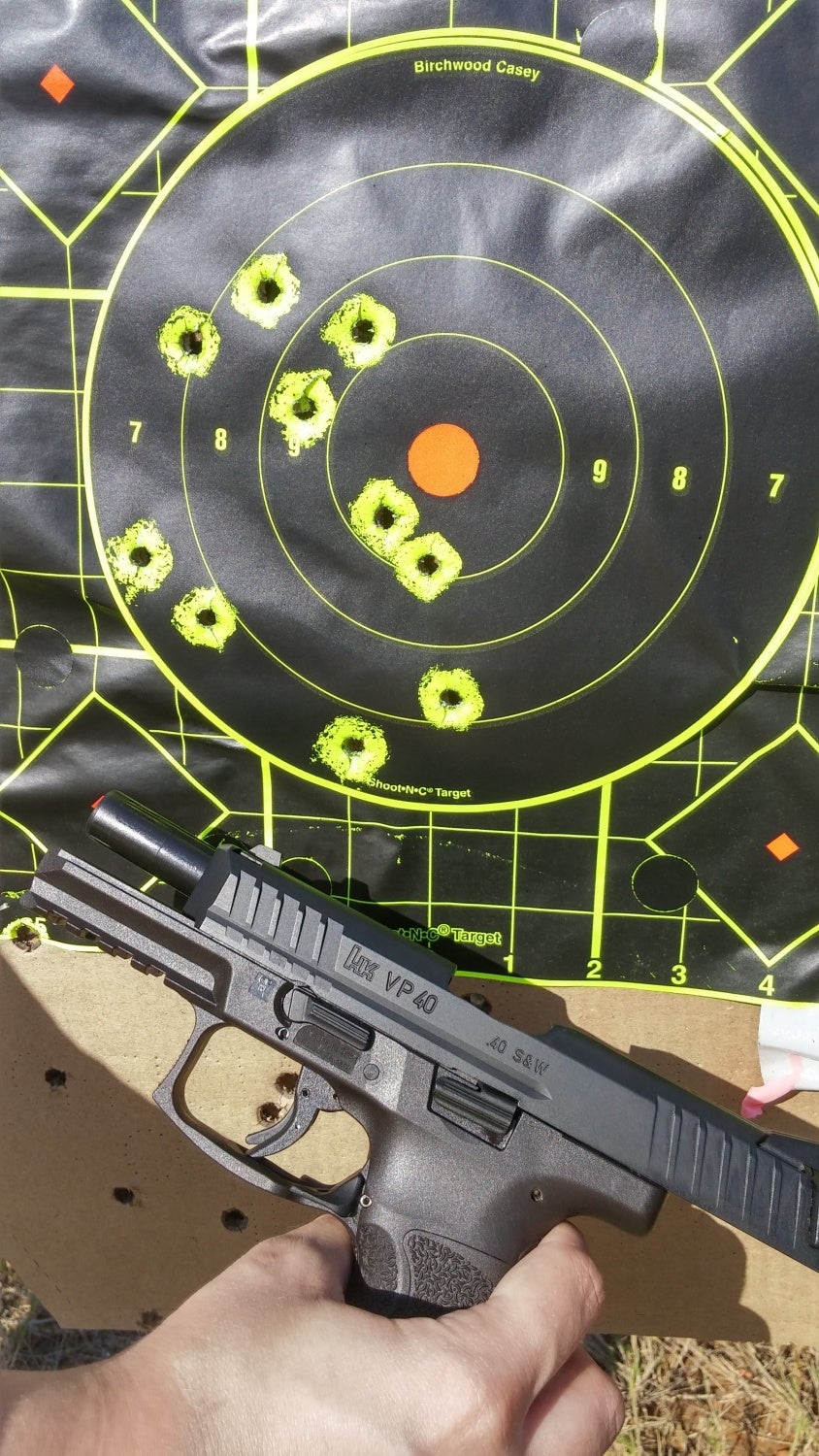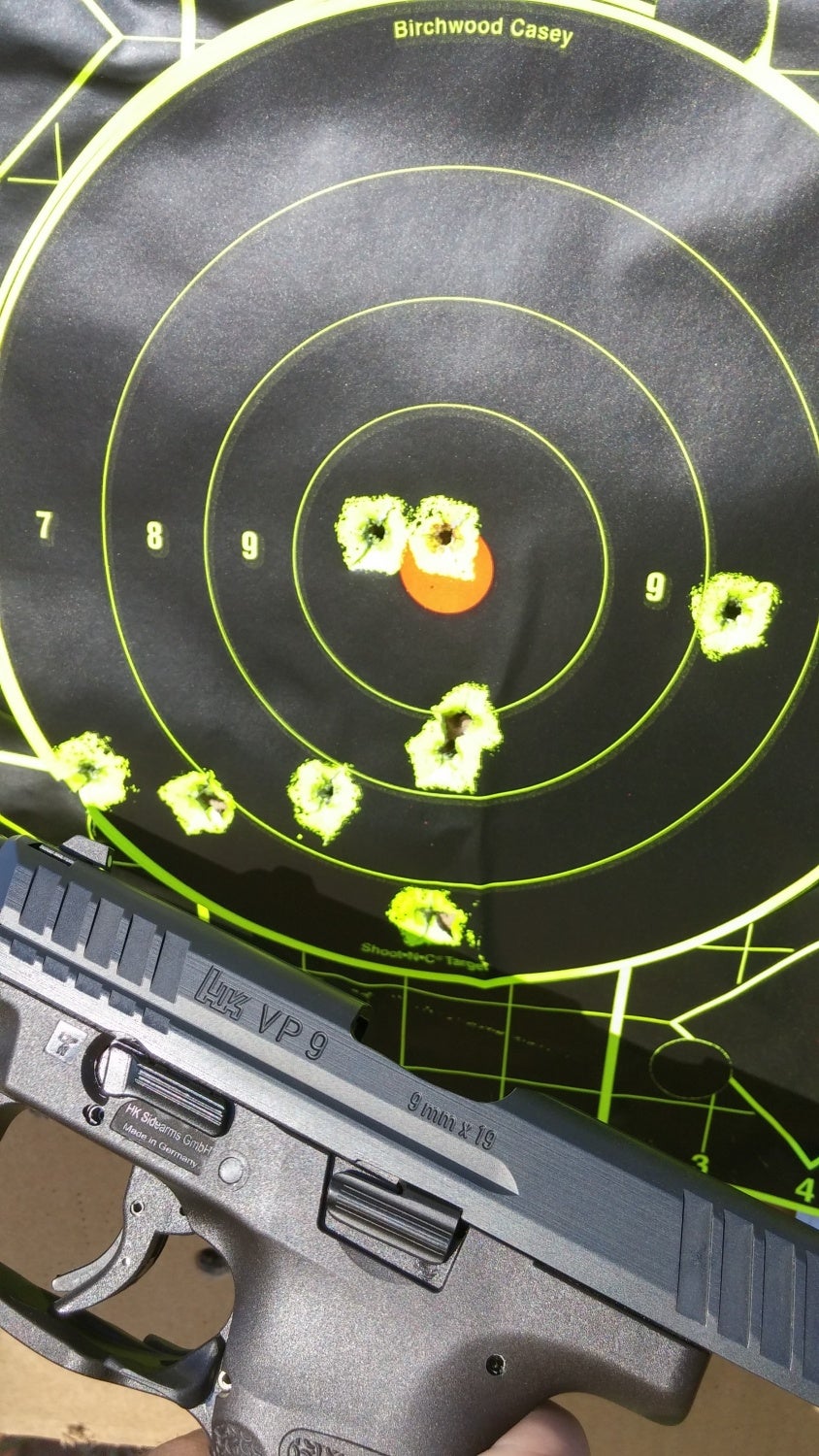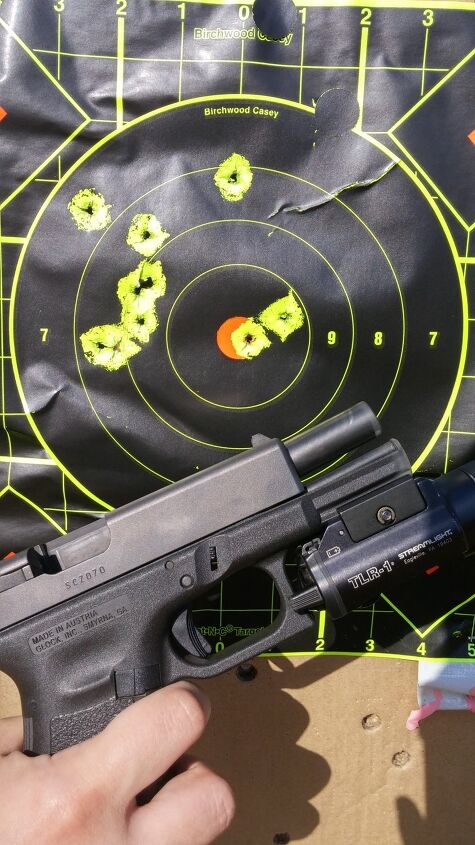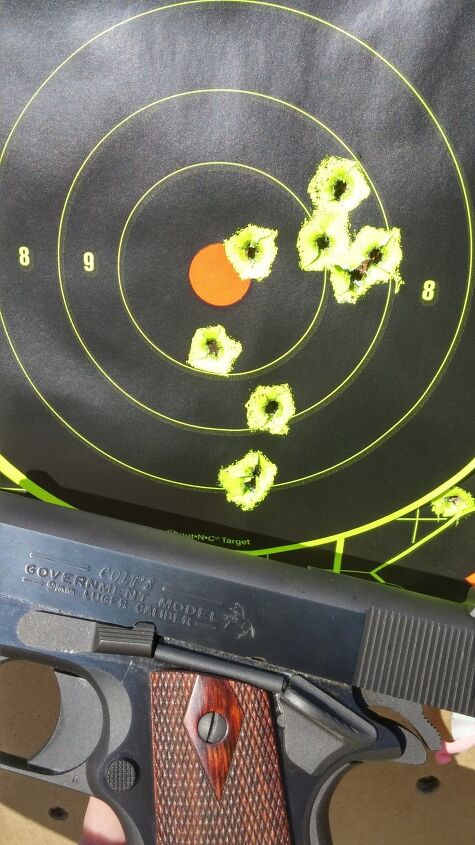Heckler & Koch has had an unusual relationship with the striker-fired handgun. The world’s first polymer-framed striker-fired production pistol, the VP70, was an H&K, and what many consider to be the company’s finest handgun ever, the P7, was also striker fired. However, aside from those two, Heckler & Koch had not produced any other striker-fired handguns, despite being one of the world’s major pistol design and manufacturing firms. Had, that is, until the summer of 2014, when the company released a brand new handgun, which harkened back to the aforementioned VP70 with the name VP9.
Following right on its heels later that year was its bigger brother, the VP40, a pistol that as we’ll see is not just a rechambered VP9, but a truly larger handgun using the same basic design. Heckler & Koch reached out to The Firearm Blog to review these two handguns together, to compare and contrast them with each other and with other firearms. To accomplish this, I chose to evaluate not only a Glock 19 – the Austrian direct competitor to the VP9 – but also a Colt 9mm Government Model 1911 alongside the two guns. Given the reputation both volkspistoles have received for having excellent triggers, the latter should give us a proper base of comparison. Neither the Glock nor the Colt have had any modifications made to them of any kind; both are completely bone stock (even my Glock’s sights are stock, something that gun experts web-wide tell me is very dangerous, for it risks the wrath of the heavenly SEALs who ride their RHIBs across the night sky bestowing blessings upon the properly tactical, and curses upon fudd apostates).
The VP9 is a 15-shot semi-compact service handgun in 9x19mm Parabellum. It is rated for 9x19mm NATO ammunition, as are all HK firearms. Its stablemate, the VP40, has a reduced capacity of 13 rounds of .40 S&W, due to the increased diameter of the ammunition. Oddly, the “VolksPistole” designation of both firearms is the regional name for the US; abroad the guns are called “SFP9” and “SFP40”, the “SFP” referring to “Striker-Fired Pistol”. Both handguns feed from P30 magazines of their respective calibers. Unlike the P30, the VP/SFP series does not use different trigger modules, having only one type of striker fired mechanism.
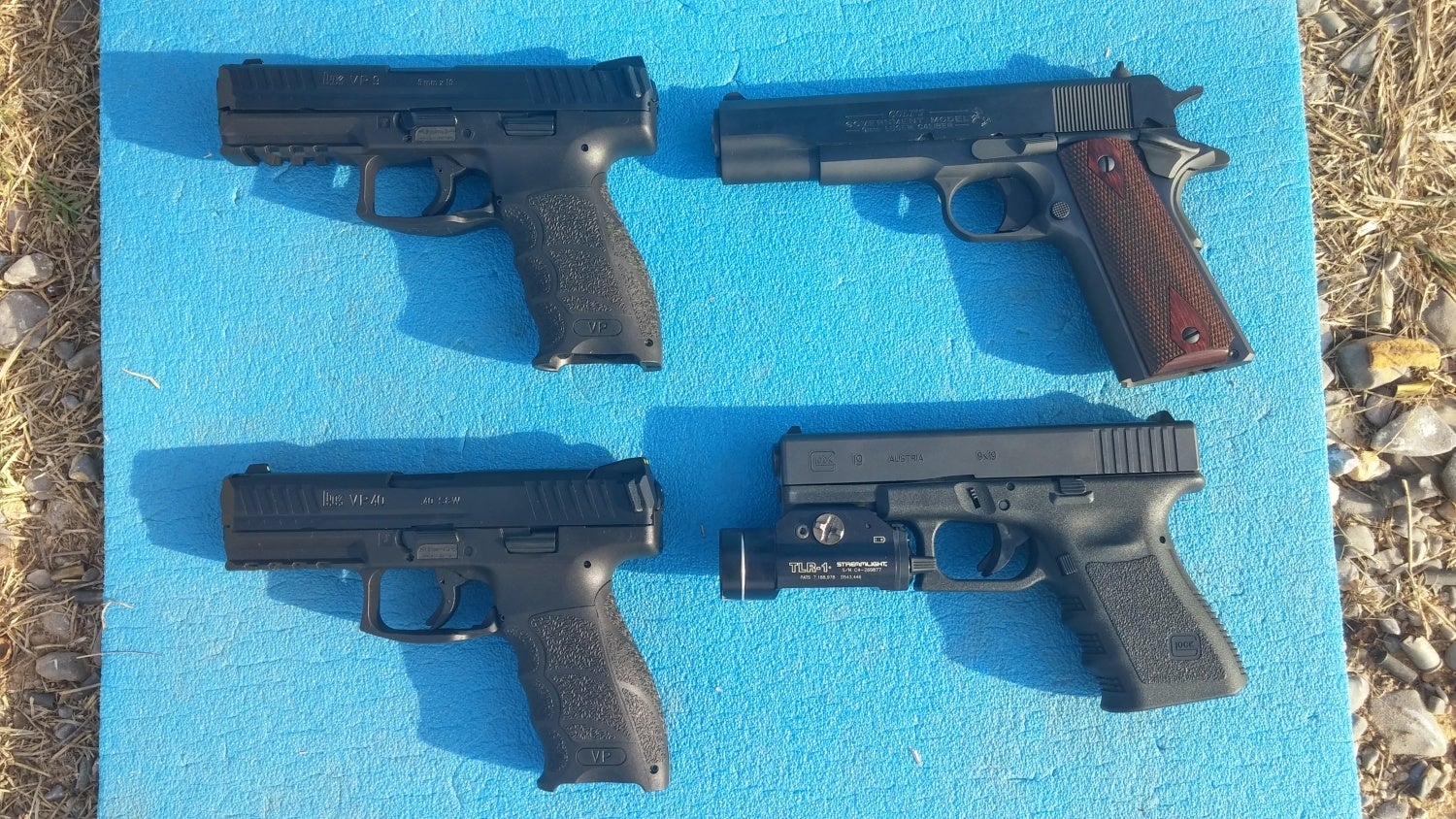
The four handguns together. Note that the volkspistoles are closer in size to the Colt 1911 than the Glock 19.
I received the VP40 first, and my initial impression was that the gun is unusually large. The slide was extremely wide, and the frame taller than I had expected. The VP40 is much larger than a Glock 19, and by extension the competing Glock 23:
The VP9 arrived later, and while it’s noticeably smaller than the VP40, it is still a significantly larger handgun than its competitor:
Compared to each other, the Volkspistoles are close but distinct in size, with the biggest difference being the thicker slide on the VP40:
In terms of basic fit and finish, the VPs were exactly what one would expect from H&K: Seductively finished major metal components, tough but plasticky plastic components, and a handful of regrettably cheap-looking stamped steel parts. Among polymer striker-fired handguns, though, the VPs are a pair of made-to-order Rolls Royces in terms of appearance.
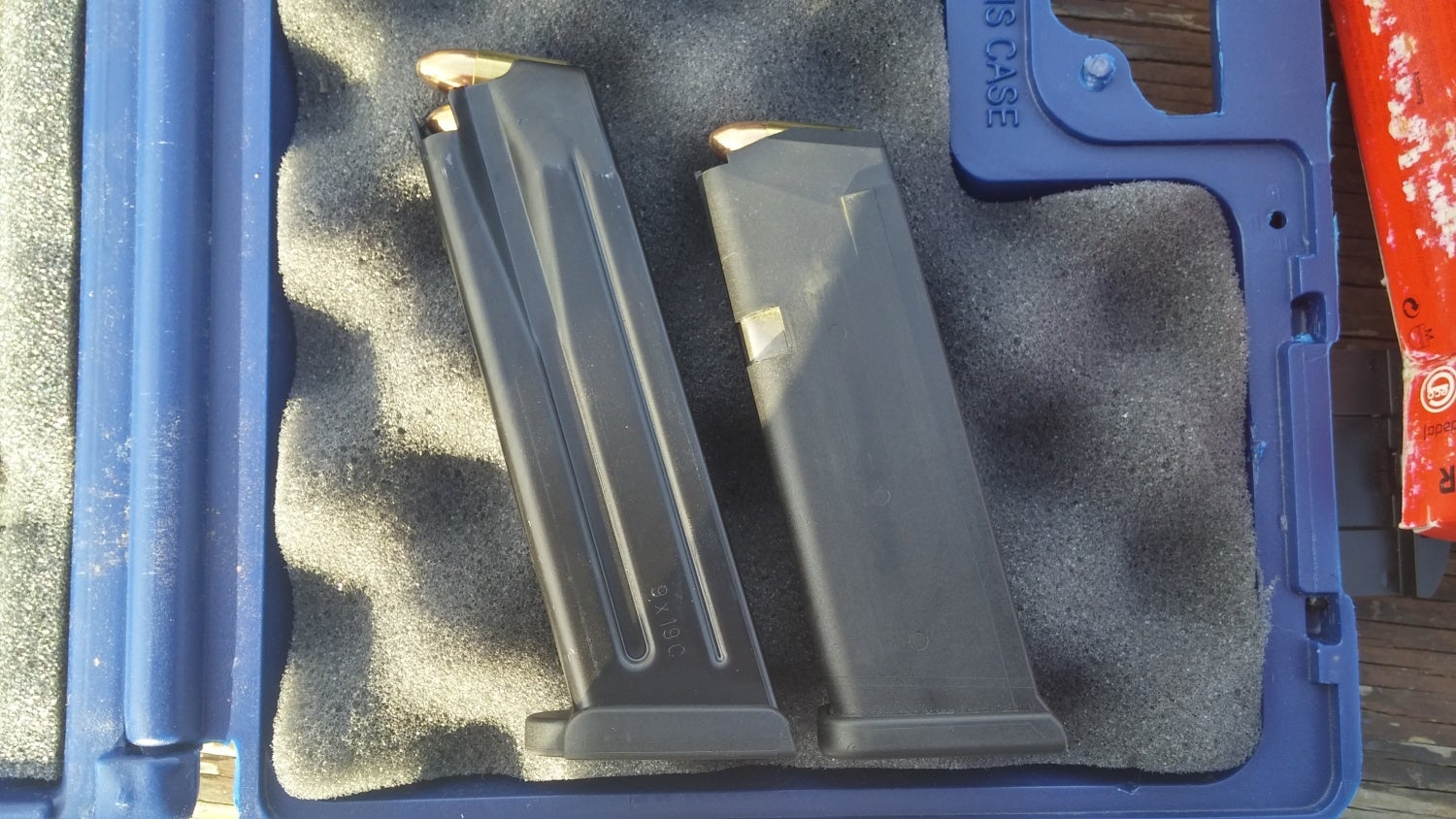
On the right is a Glock 15-round 9mm magazine, and on the left is an H&K 15-round 9mm P30/VP9 magazine. Note the greater size of the H&K magazine.
A major selling point of the VP series is their supposedly lighter, better trigger. My impression of the trigger was that it did not have a different feel to the Glock’s, but it was certainly lighter. Interestingly, Heckler & Koch went to great pains to re-work the striker mechanism in the VP series to give a different, crisper pull, and I was surprised that this seemed to make no difference in the overall character of the trigger. However, as is shown below, the pull was significantly less than the Glock and very close to the Colt:
And the VP40:
One thing to notice is the good consistency of pull for both VPs versus the Glock below. This is due to the Glock’s trigger safety, which is straight and makes it very difficult for a pull gauge to find purchase on the trigger while disengaging it. The VP series has a bow- or crescent-shaped safety that guides the gauge properly to the middle of the trigger while still disengaging. This is in my opinion only an issue when measuring the trigger with a gauge. It may be that I am just extremely used to the Glock’s trigger, but I have never felt this affected my shooting with the Austrian handgun. My opinion is that in practice the Glock’s trigger is just as consistent in pull as the VPs’ or Colt’s, though obviously considerably heavier than either:
For a seasoned Glock shooter, the Heckler & Koch volkspistoles offered very little new. Their shooting characteristics are very nearly identical, with the exception of a somewhat higher bore axis that I found reduced my speed (though it’s not like I was Jerry Miculek to start with). That’s not to say that the VPs offer nothing over the Glock. One of the quirks of Gaston’s design (at least for me) is the need to rotate the firing finger down and away from the frame to avoid “dragging wood” which can have a significant negative effect on accuracy. This has, with considerable practice, become second nature to me, but I found that it was unnecessary with the VP9 and VP40. Further, both H&Ks have the same modular, contoured P30-type grip that has become famous for its good ergonomics. Again, as a Glock person, I actually find this grip a little strange and difficult to index, but for those who do not like Glock grips the VPs do offer a highly customizable alternative at a reasonably competitive price. One minor ergonomic note is that the placement of my hands caused – almost without fail – my thumb to push down on the slide release during shooting, which resulted in the slide going home at the end of every magazine. This is an issue of the shooter adjusting to the handgun, and based on my past experience with practice I would be able to avoid this problem, but since the VP series has a very generously sized slide release assembly, it is worth mentioning. Finally, it was my hope that the large size of the VP40 would pay dividends in terms of recoil impulse, but despite this, I found that the VP40 recoiled significantly harder and more sharply than any of the other three.
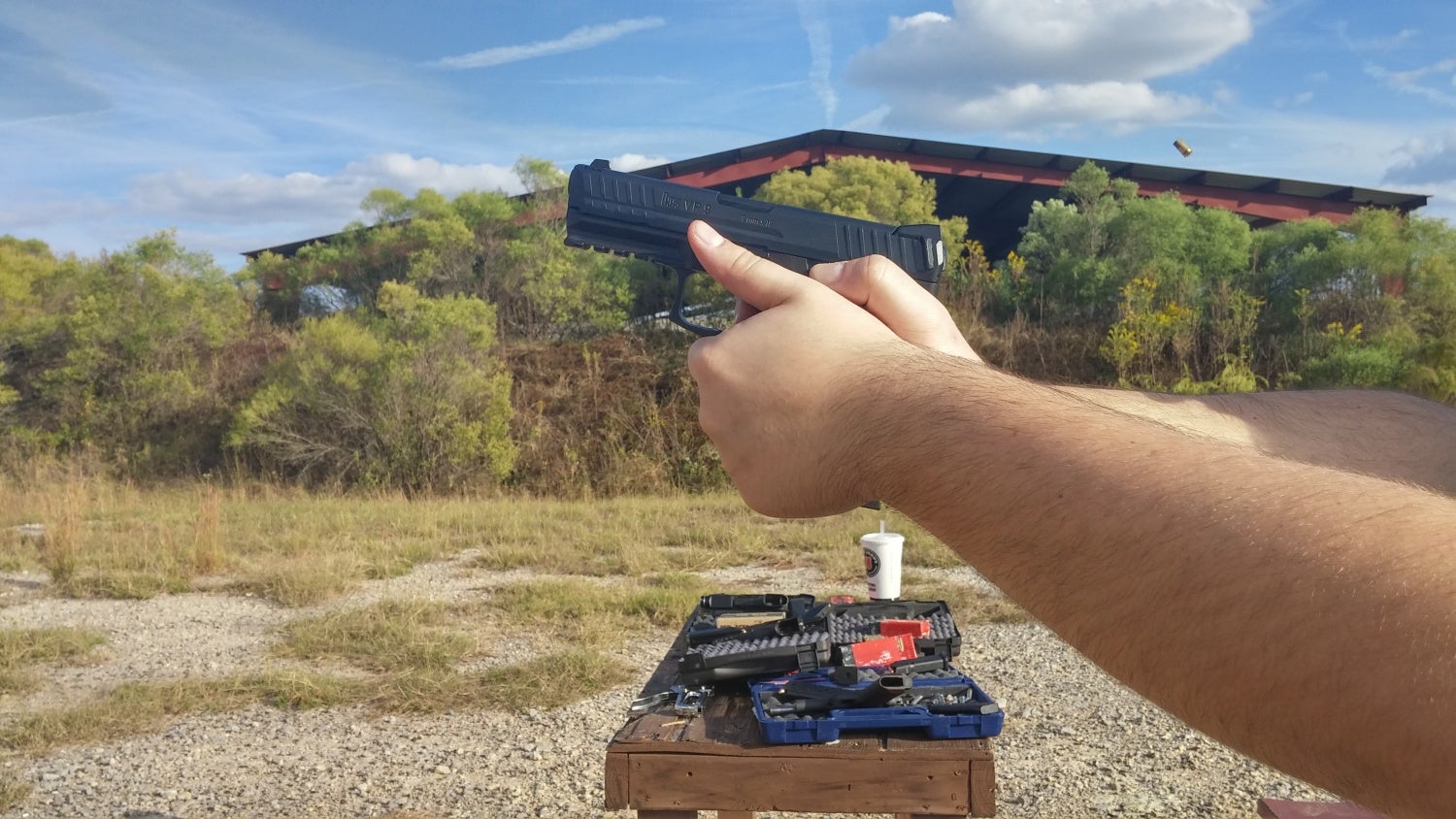
The H&K VP9 in full recoil during slow fire. Note the placement of my thumb, right over top of the large slide release. This induced failures of the slide to lock back.
Mechanically, I had no failures (aside from the aforementioned shooter-induced slide lock failure), mechanical problems, or other functioning problems.
For accuracy, the VPs shot very close to the Glock 19 at 10 yards. The VP9, Glock 19, and Colt were all were fed Geco 124gr 9x19mm ammunition, while the VP40 was fed Perfecta 170gr .40 S&W. Neither brand is the highest end, most accurate available, but I am also not the most accurate shot with a pistol. The results should still be illustrative; below are some representative groups shot during the several range sessions I took with the guns:
In this case I shot my Glock 19 with the TLR-1 light that normally lives on the rail, but it didn’t affect the group size. Group sizes are roughly the same, with the Glock being perhaps a little smaller:
The Colt printed a tighter 9-shot group side to side that strung vertically, probably due to my own error:
The H&K VP series are Glock alternatives that may appeal to those who do not think the Glock is the right handgun for them, but still want a polymer-framed striker-fired pistol with the same features (or lack thereof). Its lighter trigger doesn’t represent a revolution in striker-fired trigger technology, but it might offer some shooters with lower hand strength a less fatiguing shooting experience. The interchangeable grip panels and backstraps make for a gun that is more customizable than a Glock. Unlike the more expensive and (in my experience) more accurate P30 series, the VPs seem to offer similar accuracy to Glock handguns, although that may not be true for every kind of ammunition. For those who already have gotten used to the Glock platform, the VP series does not really offer much different, except a more pleasing finish and appearance. However, given that there is no “best” handgun, even within the striker-fired, polymer-frame semi-compact service handgun category, the VP may be a welcome addition for those who previously could not find the striker-fired handgun that is right for them. Some shooters may find their size and shape more forgiving than that of other handguns, while Glock-shooters like myself will mostly find them to be redundant to and bigger than the old Austrian standby.
The Good:
-Lower weight trigger than a Glock, comparable to factory 1911 trigger weight
-Interchangeable backstraps and grip panels give a large number of grip configurations
-Just as accurate as a Glock
-Much better looking in my opinion than either a Glock or M&P
The Bad:
-Very large for their class
-Not as accurate as the P30 series, in my experience
-Higher bore axis led to more muzzle flip
-Retails for about $100 more than a Gen 4 Glock 19
The Ugly:
-There is really nothing ugly about the VPs.
 Your Privacy Choices
Your Privacy Choices

